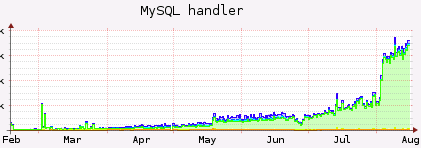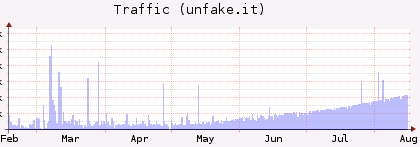Hi there,
during the past few days, unfake.it‘s performance increased dramatically. Several scripts and jobs have been moved onto new servers, the database structure and various SQL statements have been enhanced and even SQL SELECT statements have been optimized to more and more use readonly slave servers. Most URLs are being faked in much less than a tenth of a second. The magical previews of faked URLs are generated almost instantly, since performance increased dramatically.
Unfortunately, faked URLs weren’t posted to Twitter when using the WordPress Plugin during the past 4 hours due to a tiny misconfiguration. This issue could be solved.
unfake.it has become a more and more commonly used URL shortener during the past months. Almost 1.000 URLs are faked in a 24 hour period, even though this magic edge has not yet been crossed. See the stats for more information ’bout that.
Bye, Thomas
Hi zusammen,
ich bin seit ich denken kann Kunde bei der Sparkasse. War auch eigentlich immer zufrieden, bis dann vor ca. 2 Jahren meine persönliche Bankberaterin gewechselt hat. Verschiedene Dinge, die bis dato relativ einfach und unkompliziert gingen, waren dann deutlich anstrengender und waren nur noch auf massives Drängen überhaupt möglich.
Kurzum: es wurde mit der Zeit immer schlechter. Im Frühjahr diesen Jahres hatte ich dann ohnehin schon den Entschluss gefasst, mein Konto komplett zur DKB umzuziehen, was ich auch erfolgreich getan habe. Nur noch ein paar Daueraufträge und Abbuchungsaufträge muss ich umziehen.
Heute dann wieder ein neues Aha-Erlebnis mit der Sparkasse. Ich leere meinen Briefkasten und finde dort eine in Plastikfolie eingeschweisste Broschüre. Allein die Verpackung ist umwelttechnisch schonmal eine Frechheit – aber egal.
Ich mache das Dinge also auf und finde ein Deckblatt, welches mich auf die geänderten Geschäftsbedingungen hinweist, welche beiliegen sollen. Ich suche also diese neuen Geschäftsbedingungen und stelle fest, dass die 34seitige Broschüre die neuen Geschäftsbedingungen sind. Ja, 34 verdammte Seiten mit Kleingedrucktem. Und die gelten, sofern ich nicht binnen 6 Wochen widerspreche.
Meine Güte, wer denkt sich denn sowas aus? Meinen die tatsächlich, dass irgendein normaler (und arbeitender) Mensch diese 34 Seiten durchliest, um die Änderungen und Unterschiede zu entziffern?
Die spinnen ja wohl!
So long, Thomas
Hi there!
Quite a while ago, I started writing my first and own facebook application. I got stuck while trying to publish content to my own profile page and also to my friends’ newsfeeds. I stumbled upon several problems. Either there was no content displayed, it was formatted in a wrong way, it was not published on my friends’ newsfeeds or it even was published on behalf of my friends’ username. It was quite strange to me and I could not find an easy documentation on how to do it the right way.
I played around with Stream.publish, Feed.publishUserAction or Notifications.send – none of those functions did what I wanted them to do. This may be so, because I did not fully understand their purposes.
So, this is my way to do it. I am using the FBJS (FaceBook JavaScript) popup call Facebook.showFeedDialog. This is truely (as far as I’m concerned) the best and easiest way.
First of all, I assume you are familiar with how to build an facebook application from scratch. If not, please read the developer’s documentation.
Step 1: build and register your Feed Template Bundle
- go to the Feed Template Console
- choose your application and hit “Next”
- create a template for your “One Line Story” and hit “Next”
- create a template for your “Short Story” and hit “Next”
- create Action Links and hit “Next”
- hit “Register Template Bundle”
- copy and save the Template Bundle ID given in the popup (you will have to paste it into your application’s code later)
When doing this, you may enter any text or even HyperText in the fields for the One Line or Short Story. You also may enter predefined tags such as {*actor*} or your own defined tags such as {*foobar*}. In the Sample Template Data, you may enter the tag definitions and display a preview. What you enter there and at this very moment has no effect on the content displayed within your application later! That’s just for previewing purposes. The real content will be defined later in your application’s script. Remember that! Some Examples for your Sample Template Data at this point may be:
1.{"foobar": "This is a foobar text"}Or a bit more complex:
1.{"foolink": "<a href="http://www.google.com/">Google</a>",</p>2.<p>"images":[{"src":"http://domain.com/image1.jpg", "href":"<a href="http://www.facebook.com/&;quot;>http://www.facebook.com&;lt;/a>"},</p>3.<p>{"src": "http://anotherdomain.com/image2.jpg", "href":"<a href="http://www.facebook.com/&;quot;>http://www.facebook.com&;lt;/a>"}]}You see, e.g . the {*images*} tag is defined as some sort of array consisting of multiple SRC and HREF values. Attention: the special tag {*images*} is displayed automatically on Short Stories, you don’t need to call them!
2. write your application’s content
01.<?PHP</p>02.<p>require_once 'facebook-platform/php/facebook.php';</p>03.<p>$appid = 'xxxxxxxxx'; // your app ID</p>04.<p>$appapikey = 'XXXXXXXXXXXXXXXX; // your app key</p>05.<p>$appsecret = 'XXXXXXXXXXXXXXXX'; // your app secret</p>06.<p>$template_bundle_id = 'xxxxxxxxxxxxxxxx'; // the ID you got in Step 1</p>07.<p>$facebook = new Facebook($appapikey, $appsecret);</p>08.<p>$user_id = $facebook->require_login();</p>09.<p>echo "<p>Hello, <fb:name uid=\"$user_id\" useyou=\"false\" />!</p>";</p>10.<p>?></p>11.<p><script type="text/javascript"><!--</p>12.<p> var template_bundle_id ="";</p>13.<p> var url="http://www.google.com/";</p>14.<p> var user_message_prompt = "Share this URL with your friends?";</p>15.<p> var user_message = {value: "wants to share a greate website."};</p>16.<p> var image ="http://www.google.com/intl/en_ALL/images/logo.gif";</p>17.<p> var template_data = {"url": url,</p>18.<p> "images": [{'href': url, 'src' : image}]};</p>19.<p> Facebook.showFeedDialog(template_bundle_id, template_data, '', '', '', user_message_prompt, user_message);</p>20.<p>// --></script></p>21.<p>This is it.
Every time you call your application’s page, you’ll get a facebook popup asking you to display the content on your profile and even in your friends’ newsfeeds. Of course, it does not make any sense to share some data every time you call your application’s canvas page, so you may want to add some more code to your application.
The text to be shared is the text you entered when registering the Template Bundle in Step 1. If you get an error, please make sure the defined variables (such as “url” or “images”) are valid and do exist. In other words: whatever you call in your Template Bundle, it has to be defined in your script.
Of course, you may generate the content dynamically from a database or any other source.
I hope this HOWTO helped.
Bye, T.
Hi there,
after several months, unfake.it has become even more important in the Web2.0 community. A few weeks ago, I was talking to some guys and co-workers about programming and such things. I then told about unfake.it and a co-worker of mine said, he somehow stubled upon http://unfake.it/ and uses it irregular. That was quite funny to me.
I’ve had very few time the past months and since I got stuck on the half way because of some WordPress problems and also some problems with facebook’s API and FBML, there was no more development. But now I’m proud to announce that today, I released a completely new version including new features:
WordPress plugin version 1.2
The new plugin comes with its own settings page and adds two own tables to your WordPress installation. The main purpose is to let you configure, whether or not you wish to be taken to facebook and add the shortened URL for your new blog post (including a thumbnailed screenshot) to your facebook profile page and even in your friends newsfeeds.
Facebook application
unfake.it now has its own facebook application which lets you add shortened URLs, lists them as screenshots in a profile box, displays about new URLs on your profile wall and even tells your friends about it in their newsfeeds. Want an example? See:
Since a few hundred URLs are shortened every single day, I also had to do some enhancements to the database structure and especially to the thumbnailing process. Just think about it: at the moment, we have more than 20,000 shortened URLs, each of them was once and initially thumbnailed, stored and is re-fetched every few days, if still hits occur. That’s a lot of traffic and a lot of CPU power. Just take a look how MySQL handlers and Apache traffic increased the last months:
You may see most recent stats at http://unfake.it/stats.php.
Please let me know, if you have any problems with the new version of the WordPress plugin and especially what you think about the facebook application.
Bye, T.
Hi there!
 Do you know this problem?! You have to get up at some certain time in the morning, so you set up your alarm clock to give you a friendly “rrrrrrring-rrrrring”. But you simply don’t wake up! Your alarm clock rings and rings and rings for like hours but you simply don’t hear it. Sometimes, you use the snooze button, but you cannot even remember you did it.
Do you know this problem?! You have to get up at some certain time in the morning, so you set up your alarm clock to give you a friendly “rrrrrrring-rrrrring”. But you simply don’t wake up! Your alarm clock rings and rings and rings for like hours but you simply don’t hear it. Sometimes, you use the snooze button, but you cannot even remember you did it.
Well, that’s like how I feel sometimes in the morning. Bad thing, if you have some kind of meeting or appointment. Several times in the past, I sent automated e-mails to my co-workers to give me a wakeup call on my cellphone, this surprisingly always works. But it’s annoying. For me and my co-workers.
Here comes the solution:
use nagios to give you a highly sophisticated wakeup call.
Imagine, you have a linux box which is under surveillance of a nagios remote monitoring system. And imagine furthermore, this nagios system is configured to send out voice calls in cases of critical states. All you need is a new plugin (most commonly via NRPE) which tells nagios to initiate your wakeup call.
This is how I do it:
1. Add the following line to your NRPE config file on your linux box (e. g. /etc/nagios/nrpe.cfg):
1.command[wakeupcall]=/usr/lib/nagios/plugins/wakeupcall2. Create the plugin and place it on your linux box at /usr/lib/nagios/plugins/wakeupcall
01.#!/bin/bash02.#03.# nagios nrpe plugin to initiate a wakeup call04.# 2009, Thomas Gericke, thomas (at) thomasgericke (dot) de05.#06. 07.FILE="/etc/wakeupcall/wakeupcall"08. 09.if [ -e $FILE ]; then10. echo "Wakeupcall needed. Gonna hit ya!"11. exit 212.else13. echo "No wakeupcall needed. Sleep well."14. exit 015.fi3. Restart your NRPE service on your linux box (e. g. /etc/init.d/nagios-nrpe-server restart)
4. Set up the service check in your nagios configuration on your nagios server
I assume, you already have the host configured on your nagios system and you already are familiar with nagios’ notifications. Here’s the service check you need:
01.define service {02. use generic-service03. max_check_attempts 104. notification_options c05. service_description Wakeup Call06. host_name YOUR.HOST.NAME07. check_command check_nrpe!wakeupcall08. contact_groups YOUR_CONTACT_GROUP09.}I hope you’re familiar with nagios’ service check templates and such stuff.
5. Reload your nagios on your nagios server (e. g. /etc/init.d/nagios reload)
6. Create the wakeupcall config directory on your linux box (mkdir /etc/wakeupcall/)
7. Set up a file for an at-job on your linux box (e. g. ~/add.wakeupcall)
1.touch /etc/wakeupcall/wakeupcall8. Set up an at-job on your linux box once you need to be woken up
1.at -f ~/add.wakeupcall 06:40Your linux box will create /etc/wakeupcall/wakeupcall at 6.40AM (the very next time this moment occurs), nagios will realize it and will initiate the notification. If you have configured your nagios server to send out voice calls to your cellphone, you will receive a wakeup call.
Have fun, comments are appreciated!
Hallo zusammen, erneut ein Beitrag in deutscher Sprache…
Ich tue mit dem Posting das, was etliche meiner Kollegen und Bekannten auch bereits getan haben: den Beitrag mit dem Titel “Heftige Proteste gegen Sperrungen im Internet” aus der Sendung Zapp auf NDR vom 20. Mai 2009 (23.15 Uhr) weiter zu publizieren.
In dieser Sendung wird Frau von der Leyen zu recht stark kritisiert und erstmalig auch von tatsächlichen Missbrauchsopfern aufgefordert, ihr absolut wahlkampfreifes, allerdings total überzogenes, sinnfreies und laienhaftes Unterfangen der Internetzensur aufzugeben. Christian Rüdiger Bahls, selbst Missbrauchsopfer und (Mit-)Begründer des Vereins “MissbrauchsOpfer Gegen InternetSperren” (MOGIS), spricht offen aus, was viele Menschen denken:
“Frau von der Leyen, Sie packen das Problem nicht an, Sie verstecken es hinter einem Stoppschild. Sie verschliessen Ihre Augen vor Kindesmissbrauch und schauen feige weg, anstatt den Missbrauch aktiv zu verhindern.”
(freie Interpretation meinerseits)
Schlimmer noch: der im Wahlkampf 2009 sicherlich werbewirksame Wunsch, Kinderpornographie per Knopfdruck abzuschalten, sorgt nur dafür, dass unbescholtene Bürger schlussendlich in das Fahnungsraster des Bundeskriminalamtes gelangen, während die tatsächlich Kriminellen mit wenigen und effektiven Handgriffen Frau von der Leyens lächerliche Sperren umgehen und unkontrolliert ihrem Werk nachgehen.
[youtube]evXQwqIBd04[/youtube]
Frau von der Leyen, Sie mögen es vielleicht verstehen, sich durch politische Diskussionen in die Medien zu katapultieren, derart dilletantisches Vorgehen hat allerdings durchaus schon ganz andere politische Karrieren beendet.
Gute Nacht.
Hallo zusammen,
erst heute bin ich durch http://www.zensursula.net/ auf das nachfolgende kurze Telefoninterview mit Ursula von der Leyen zum Thema DNS-Sperren gegen Kinderpornographie gestossen. Was ich da gehört habe, schlägt dem Fass den Boden aus!
Frau von der Leyen gibt an, dass rund 80% der Internetnutzer die “ganz normalen User des Internets” sind, während die restlichen 20% die versierten Benutzer sind, die Sperren im Internet umgehen könnten, die zum Teil “schwer pädokriminelle“ sind, die sich “in ganz anderen Foren” bewegen und “natürlich auch geschult im Laufe der Jahre in diesem widerwärtigen Geschäft“ sind.
Ein Klick hier spielt das Interview (38 Sekunden) ab
Frau von der Leyen, das war ja wohl mal ziemlich daneben. Ich bezeichne mich selbst als sehr versierten Internetnutzer, falle also in Ihre 20%-Gruppe und fühle mich ziemlich über einen Kamm mit Straftätern und Kinderschändern geschoren.
Ich denke und hoffe, die 20% der versierten Internetnutzer werden so viel wie möglich der restlichen 80% darüber aufklären, wie Ihre DNS-Manipulation und damit Ihre Zensur im Internet umgangen werden kann. Ihr Ansatz, Frau von der Leyen, ist grundfalsch. Warum packen Sie das Problem nicht da an, wo es nötig wäre: beim wirklichen Übel?
Guten Abend.





